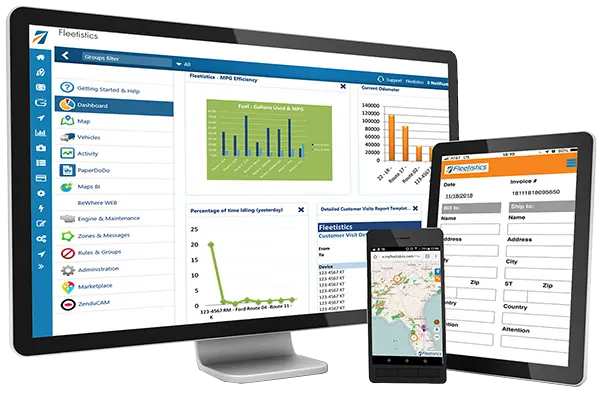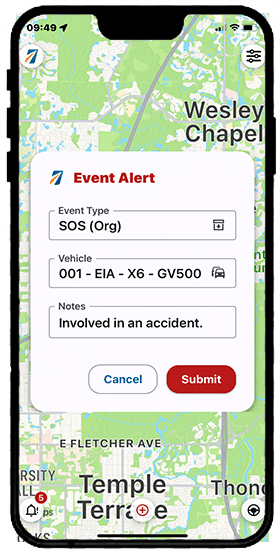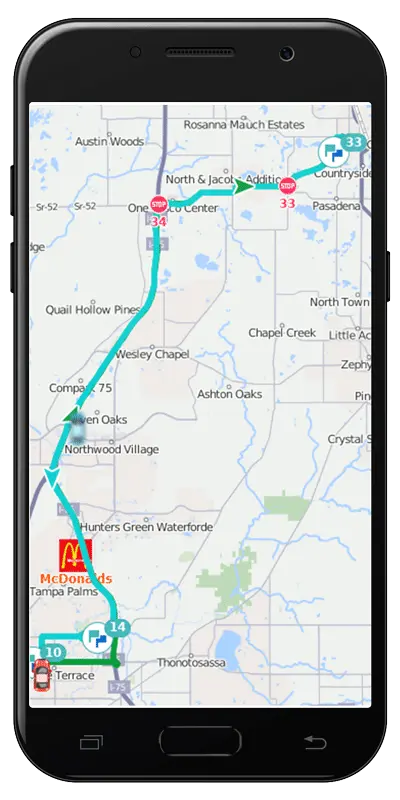Fleetistics Fleet Management Blog
How to Introduce GPS Tracking to Employees
How to Introduce GPS Tracking to Employees
This is a popular question since managers are concerned about the reaction of drivers. Managers do not want to make drivers feel untrustworthy but at the same time there is a need for metrics and accountability.
Questions and concerns include: 1. Will my drivers quit. 2. Will GPS tracking build a wall between management and employees. 3. How will my operation change when we introduce GPS tracking?
These are valid questions to be discussed with your GPS tracking provider. This article will provide enough guidance to get you through the process with confidence. In today’s service sector, GPS tracking is so common that it is generally not a big issue.
Dashcams are the next technology fleets are implementing for accident liability mitigation. Being visible on video is a different challenge but so is the issue of distracted driving due to cell phones.
Best practices to introduce gps tracking to employees
“After 22 years of helping customers implement GPS tracking technology, there is nothing more important than implementing a policy you are willing to enforce. If you are not willing to enforce the behavior you want, you are wasting your time and money. Best in class customers will experience an ongoing ROI of 10x the investment.”
Eron Iler
President
Driver preparation
Introducing employee GPS tracking an be tricky and drivers may push back. While working with companies who have installed a GPS fleet management system and are now reaping the rewards, we have developed this guide to help you introduce GPS tracking to employees and answer most of their questions up-front. You can make the transition much smoother by communicating with them directly, outlining not only how the company will benefit, but also how they will benefit.
Five Steps in Helping Employees Embrace Change
- Make it easy for drivers to clearly identify and understand the change.
- Help them realize that their first reaction could be rooted in assumptions, not facts.
- Clarify the company and your drivers’ interests when considering new policies.
- Do not do a covert installation and tell them after someone is busted.
- Acknowledge “big brother” is part of it just like a service ticket, QA calls, etc.
Your new GPS tracking system will help everyone become better at their jobs. The better you get, the more money you are going to make! And the healthier the company, the better off everyone will be. *Savings can translate to better 401 (k) returns, bonus programs, fewer customer call-backs, cancellation and complaints, less paperwork for timecards, better driver training, etc. It will make you a better company with the benefits you already realize and understand.
Be Honest and Forthright About the GPS Tracking System
First, be honest and forthright from the beginning and you will gain employee trust. Experience has shown that good employees have no problem with accountability and, in fact, welcome it as it sets them apart from less productive co-workers. Any employee that resists fleet tracking is more than likely an employee that could use improvement somewhere.
Some employees might also have a tendency to distrust, or at least be skeptical of change. Their resistance is rooted in unrealistic attitudes towards change. Change is continuous. It happens everywhere. It’s accelerating as technology expands. And in truth, all changes are not always bad.
Describe to the Employees How a GPS Tracking System Works
Here’s how the system works: A GPS tracking unit [show them the vehicle unit] will be installed on each vehicle. It will record the vehicle location, the exact route the vehicle was driven, time spent at each stop, and the speed the vehicle was traveling. [talk about specific information transfer here; i.e. automatic download, data key, cellular, etc.] The information will then be sorted and analyzed to determine what changes or accommodations can be made by the driver to increase efficiency.
Now, you may be asking why the company needs to know this information. Well, there are lots of reasons. One, you will be able to see if there are any changes that need to be made to the routes to save time during the day. You also want to make sure everyone is pulling equal weight. If one driver always has to scramble to make all his stops and another driver has extra time, this management system will help you pinpoint specific issues and allow you to fix them. We all want to establish daily routes that are achievable, not impossible to safely accomplish.
Also, it tells you how fast the trucks are going and gives you all an incentive to stay within the speed limit. This ultimately keeps everyone safer on the road. It proves you have a safe fleet of drivers, which may lower everyone’s insurance premiums due to fewer accidents. (See Employee Benefits).
Build Up a Good Relationship With Your Employees
A good relationship with your drivers will help your fleet run more smoothly and efficiently. Therefore, the more you can get your drivers to collaborate (partner) with the change instead of resisting (fighting) it, the better off the company will be.
This does not mean that the drivers get to decide on the use of fleet management technology.
Welcome Questions From Your Employees About the GPS Tracking Units
Open the floor to questions. If someone asks a question that you are not able to answer right away, tell him or her you’ll find the answer and get back to him or her and do just that. GPS tracking is not a mystery at this point in the technology.
Explain How Everyone Wins When GPS Tracking is Implemented
There are a lot of positives associated with GPS implementation and a lot of other companies have seen excellent results, right off the bat. For instance, a company in California realized a savings of $600 to $800 dollars a week, that’s more than $40,000 a year within two months of installation of their GPS deployment! ROI Calculator
There are also many positives for the driver. A facility maintenance company in Nevada had a driver that had been accused of causing an accident and was cleared when the system proved that the vehicle had never even been in the vicinity of the alleged accident. The company avoided an insurance scam and we see this as a win-win for everyone.
If a customer claims they never showed up, didn’t spend enough time there, or was too early or too late, you have proof to agree or refute the claim. They can’t argue with the system. This type of proof already led to lower customer turnover rates for many GPS Fleet Customers, which benefits everyone.
Points for Introducing Our System to Your Employees
It is no secret why you purchased this new GPS system: increased driver efficiency, improved route management, increased time savings, potential overtime reductions, reduced fuel consumption, and the ability to account for your fleet’s progress. But, how do you communicate those things to your employees? How do you get them to see that your new system will also benefit them?
We’ve put together the following topics to help you introduce the system to your employees. We suggest breaking down your presentation into four main points: Introducing The GPS units, describe the GPS tracking system, benefits of GPS tracking and questions & answers.
Introducing the GPS Units
Inform your employees that your company, in keeping up with current technologies, will be instituting a new fleet management system. This technology will allow the company to maintain a competitive edge in today’s faster business environment, resulting in increased efficiency, and having a positive impact on the company’s bottom line.
Describe the GPS Tracking System
Explain how the system actually works. Describe the units in the vehicles, the computer interface, and the activities that the system will record (speed, mileage, distance, stop time, stop duration, vehicle route, etc.). (Show a report generated on a day they drove a particular vehicle
Benefits of GPS Tracking
Provide an overview of the benefits the system will provide (from decreased insurance premiums to increased route management) but also discuss in detail the direct benefits to employees. You cannot avoid the “big brother” aspect of GPS tracking. Acknowledge it and describe it as another tool used by management to run the company efficiently. GPS tracking is like a work order, customer survey or other tool to help run the business.
Example
“Thank you all for joining me today. I know we all have a lot on our plates right now and that time is in short supply around here, but I think you’ll find this meeting a productive one.”
“I wanted to talk to you today about the new fleet management system we’ve installed the last few days. In order to remain competitive and to prosper in today’s hi-tech world, it is essential to be aware of trends and to stay abreast with current technologies. Electronic fleet management is revolutionizing the way fleets are managed in America today. We made an investment in this system because it will ultimately help us be more efficient and hopefully have a positive impact on our bottom line.”
Do's and Don'ts
There is no “Magic Formula” for introducing Your New GPS System to your employees. However, our experience has identified a number of “Do’s and Don’ts” to follow:
Do
- Try to introduce the system in a group meeting or other personal communication. By calling a personal meeting (or a series of small group meetings, depending on the size of your organization), you’ll give employees the opportunity to learn about the system first-hand rather than through the grapevine. It also allows them to have all their questions answered from top management.
- Keep the meetings and correspondence upbeat and positive. You may be installing the system because work isn’t up to par, but communicating this to your drivers will automatically put the system in a negative light. Talk about things you feel the company will be able to improve on because of the new system and be sure to include the positive benefits for employees.
- Establish a way for employees to provide feedback and have their questions answered once the system is in place. Encourage e-mails or memos or create a comment box through which employees’ concerns and suggestions can be heard.
- Recognize all positive changes and improvements you see once the system is up and running. Whether it’s a gift certificate or cash bonus or simply a letter from the company president, be sure to recognize and reward desired behavior. This will clearly demonstrate to employees that the system provides benefits to both the company and the individual drivers.
Don't
- Don’t install the system before informing your employees. You may be tempted to install the units without employee knowledge (covert installation) simply to track work or establish a benchmark by which to determine the system’s success. However, the headaches and potential employee backlash usually aren’t worth it.
- Efficiency starts rising from day one. Moreover, being open and honest builds trust with even the most critical employees.
Don’t hide information about the system or evade tough questions. It’s important that employees understand the system and what it’s monitoring in order to get the results you’re seeking. - Don’t expect all employees to immediately embrace the system. It is human nature to react to workplace changes with some uneasiness and distrust, and you may never win everyone over. But once employees understand what the system is designed to do and start to see increased efficiency and timesaving throughout the fleet, most will accept it and work to improve their performance. It’s been our experience that good workers, the ones you want to keep long-term, welcome the system, as it recognizes their strengths and reinforces their contributions to the company.
Tough Questions & Answers
Having helped many companies with GPS implementation, we know there will likely be some tough questions you will have to face. A list of the most frequently asked tough questions are below. While many of the answers will be based on your individual company’s policies, we have given some guidelines for communication.
Q: Don't you trust us to do our jobs?
Absolutely. We trust you but we must verify and collect metrics to help run the company efficiently. Driving a vehicle, selling, servicing, and delivering our products is a huge responsibility and that is why you are part of our team. We are installing this GPS system to help us better manage the entire fleet, not just a single truck. It will give us an overall picture of how the fleet is operating and will point out areas that we could improve on as a company. We see it as a very positive change and we think you will too.
If you have a fear of “big brother” watching get with your manager to discuss where you feel you may need improvement so we can provide the training needed. We want you to be proud of the data which shows off how great you are.
Q: Is this legal? (Consult your legal counsel)
Yes. The system is simply tracking the vehicle’s progress throughout the day and providing the same information that we would get if we were to ride around with you on your calls or asked you to write detailed route reports with delivery times and mileage.
Vehicles and your pay represent a significant investment for the company. An accident can cost the company a lot of money but also your health. Instilling a culture of fleet safety is a top priority. Everyone goes home, every night.
Q: Exactly what will this system monitor
The system will track when the vehicle starts in the morning, where and when it stops, how long it stays at each location, the speed it’s traveling between points, how long it idles during the day, the total number of miles driven, and when the equipment is turned on and off (or liftgate or other custom events). It will also indicate harsh driving, power loss, and engine fault codes (depending on the system).
Benefits to GPS Tracking Employees
The strongest method for easing the introduction of the Your New GPS Tracking System is to outline for your employees the primary benefits the system provides them. The following are some of the employee benefits that have already been reported by Other GPS Fleet customers:
Higher Customer Retention
For service drivers, retaining current customers is a high priority. In several cases, the detailed reports Our GPS Tracking System provided led to higher customer retention numbers. Simply put, customers like to see proof that service was completed on time, and by providing that proof, you keep your customers and your commission.
Protection Against False Claims
Your New GPS Tracking System provides electronic verification of service time, providing drivers with “Back Up” in case of customer challenges.
Service Time Tracking
Your New GPS Tracking System provides electronic verification of service time, providing drivers with “Back Up” in case of customer challenges.
Hands-free Mileage Log
Your New GPS Tracking System provides an accurate, hands-free mileage log, saving valuable time.
Vehicle Take Home Policies
Because evening and weekend use can be monitored, some companies are now able to allow employees to use fleet vehicles after-hours. This saves many employees, and the company valuable, time and fuel. Management may opt to charge the employee a small monthly fee for this privilege. It can be optional or mandatory. It can allow your employee to sell one vehicle and save about $300 per month.
Increased Company Profits
Increased savings and company profits translate to better 401(k) results, better maintenance programs to minimize on-the-road problems, replacement of aging equipment, etc.
New Incentives
Because Your New GPS Tracking System allows you to measure performance efficiently, you can create new incentives based solely on productivity. It is amazing to see the changes in performance once drivers take the competitive spirit to heart. Before you know it, they will be helping you find new ways of bringing in revenue.
Increased Driver Safety
Financial gain is not the most important benefit for drivers. The incidence and severity of crashes and driver fatalities increase disproportionately with speed. Because maximum speed is automatically recorded, driver safety can be easily monitored.
Improved Driver Morale
Because with Your New GPS Tracking System driver accountability is not an issue any longer, you do not run the risk of getting caught up in “Gotcha” Management. On the contrary, you now have a tool to catch your drivers doing something good so you can enhance their performance and self-esteem. Good drivers are usually reluctant to report their inefficient counterparts. In many cases, good employees wind up carrying the burden of the “Slackers”. This has an adverse impact on morale. You now have the tool to deal with unproductive drivers.
Fleetio + Fleetistics – Florida’s #1 Fleet Maintenance Team
Fleetio Fleet Management, The Ultimate Maintenance Solution
Looking for an integrated maintenance solution? Integrated with Geotab, Fleetio Fleet Management empowers your team to manage vehicles, equipment, maintenance, total cost of ownership, fuel, and more with ease.
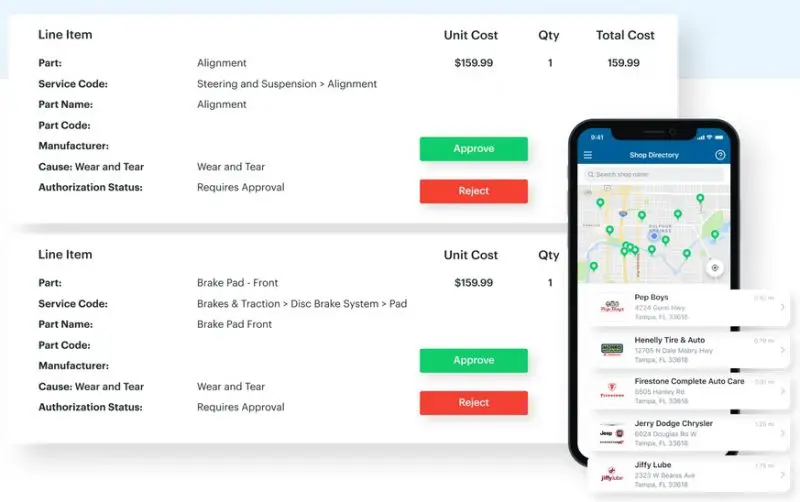
Geotab & Fleetio – A Perfect Match for Integration
- Seamless navigation between systems
- Automatic engine hour meter and milage updates
- Ability to see a vehicle’s current location within Fleetio
- Fault code and DVIR defect management
- Fuel location exception reporting
- Easy access to vehicle engine sensor data to expedite vehicle issue diagnosis
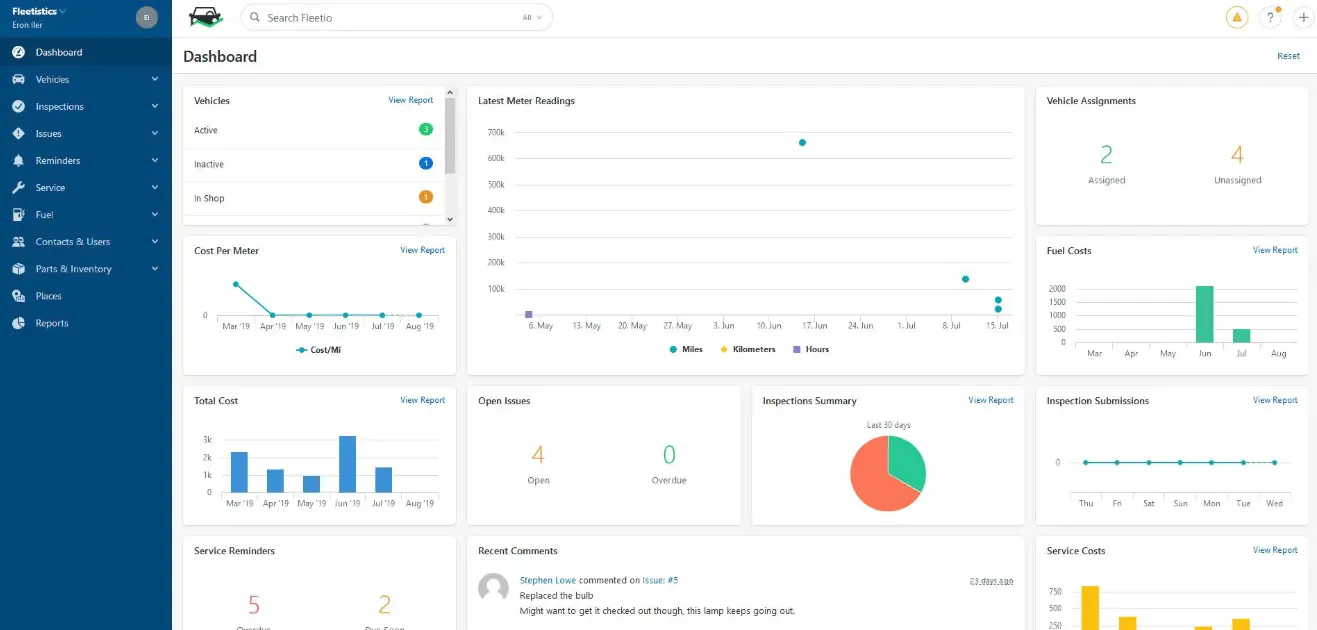
Track Every Detail
Easily monitor operational expense for both owned and leased vehicles with detailed womb to tomb service records. Effortlessly populate manufaturer recommended service schedules based on decoded VINs.
Make Better Decisions
With access to utilization data, acquisition costs, maintenance trends, and fuel economy all in one place, difficult decisions about how long to keep a vehicle and what new vehicles make sense are simplified.
Quicker Response Time = Less Down Time
Integration with Geotab DVIR and inspection workflows keep management on top of it all. If a critical item fails, Fleetio can automatically generate an issue, place the vehicle out of service, and notify the fleet manager, so those concerns can get addressed promptly and return the vehicle to the road quickly. Integration with 85,000 maintenance shops with e-order approval streamlines getting the service done quickly and maintenance cost information and billing moves seamlessly into Fleetio.
Driver Improvement Through Targeted Driver Training
Ongoing driver improvement through targeted driver training is one of the hottest trends in fleet management today
When based on actual driving history, targeted driver training is an effective tool for driver improvement. A recent article in Commercial Carrier Journal mentions the need for more targeted driver training. The article warns that in cab alerts are distracting to the driver. Classroom trainings like those endorsed by the National Safety Council are great, and have been the standard for many years, but it takes advance planning and time off the job for drivers to attend. Business requires something that is readily available when needed.
Over the past couple of years, 2 primary models of targeted driver self-improvement have emerged. Not surprisingly, they are simple merit models and demerit models.

Merit vs Demerit
Examples of merit models are game apps. Driving data is converted into a score and drivers compete for recognition. Competition is the primary motivation because it is fun, and because nobody wants to be a loser. Adding a reward, like a cash bonus for the most improved driver, maintains interest. Clearly, competition will promote driver improvement, but is still not targeted driver training.
Demerit models look for problems and assign targeted driver training. Specific behavior, for example speeding, results in lessons assigned to the driver on how speed can be dangerous. This achieves driver improvement in two ways.
- The driver learns how speed can be a danger to himself and others through the lessons assigned.
- The driver doesn’t want another course assignment that he has to complete after work hours, so he changes his behavior.
The goal is to provide a custom training course based on need. Each driver is assigned lessons based on their driving deficiencies. A program like this is often administered by the Safety Department in larger companies, but in small and medium size businesses, who is going to do all that? Many businesses would like to implement targeted driver training, but only if it is a “hands off” approach.

The Keys to Automating Driver Training
To automate the process your GPS tracking system provides the data directly to the training app. Training content on a variety of subjects is organized into courses and lessons. When thresholds for unwanted behavior are met, the app assigns the appropriate training to the driver via email. Drivers access the training from their personal devices, and no supervision is needed.
Training is easy to use, interesting, and focused on driver improvement. Managers only need to be notified when drivers fail to complete the assigned courses, but they can review lessons assigned and completed if they want. This hands off approach simplifies the managers role in the process.
Predictive Coach meets all of the criteria.
- Improves driver behaviors with a data driven training program
- Eases the burden of safety monitoring through automation
- Eliminates willful negligence around driver discipline
- Integrates seamlessly with your Geotab tracking solution
- Proven to produce results through targeted driver training
Predictive Coach automated driver training has been evaluated by Virginia Tech Transportation Institute is proven to reduce dangerous driver behavior.
How it Works
Individual Predictive Coach courses contain 3 to 7 individual lessons. The lessons are automatically assigned to drivers when exceptions to rules occur. The driving rules used are the ones you configure with tolerances you set. Managers are notified when assigned lessons have not been completed, and they appreciate the compact dashboards and reports that are available for reviewing and comparing drivers. Drivers can complete the courses on laptop, phone or tablet from virtually anywhere.
That fits our definition – automated driver improvement through targeted driver training.
Reimbursing drivers for home charging of EVs
As more companies transition to electric vehicles for their employees, it becomes necessary to establish a clear policy regarding the charging and reimbursement of take-home EVs. One crucial aspect to consider is the reimbursement of drivers for home charging of EVs. You need to have policies in place for reimbursing drivers for their actual business mileage. Calculations based on the cost of fuel or miles driven no longer apply.
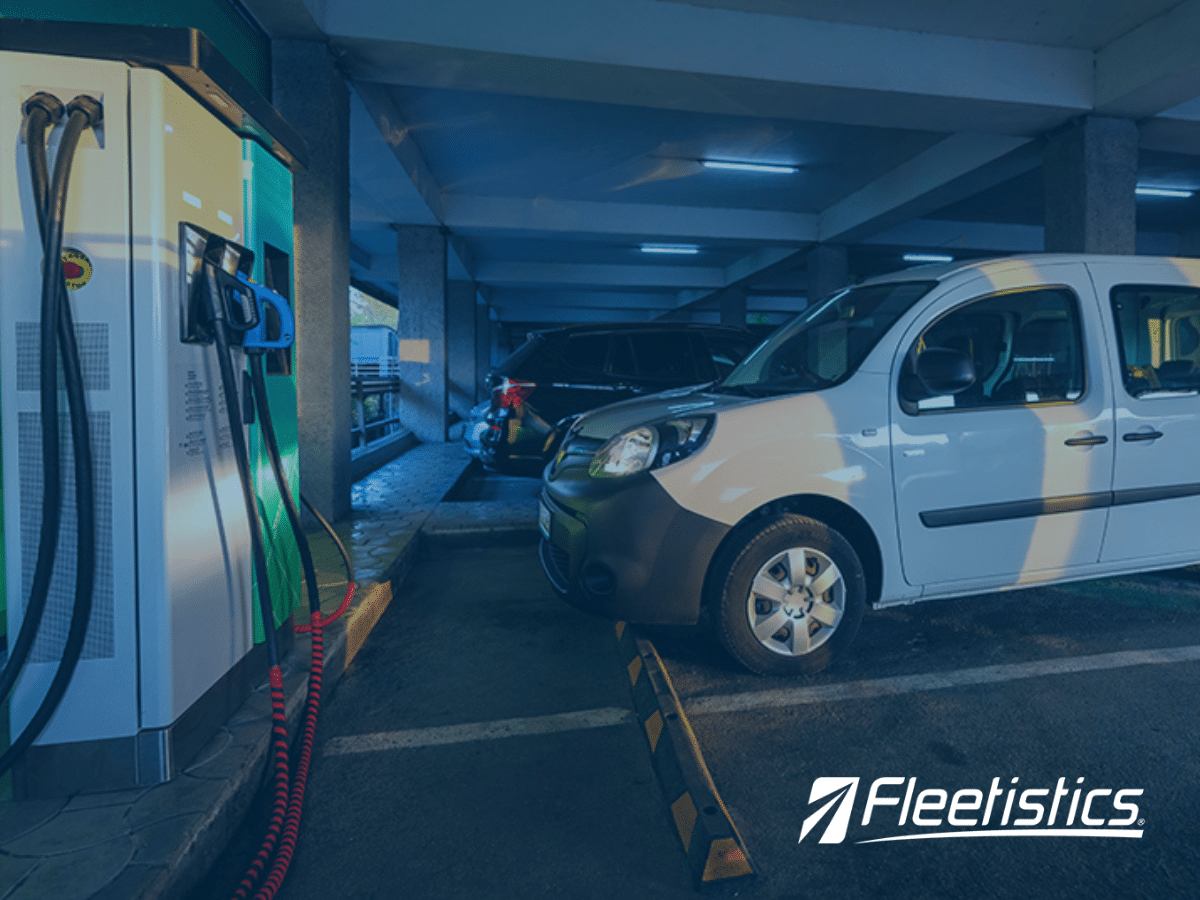
Your fleet needs to reap the benefit of the lower EV operating costs with mileage reimbursement rates that reflect the true electricity costs. That isn’t easy with a vast range of costs between peak energy use times, off-peak charges, use of fast public chargers and more. Here are a few ideas:
- Home charging infrastructure plays a crucial role in encouraging the adoption of electric vehicles. Research studies have shown that EV drivers consider the ability to charge at home as a significant incentive for purchasing an electric vehicle.
- Home charging provides numerous benefits for EV drivers, including lower pricing per kilowatt-hour compared to fast-charging stations and the convenience of charging at home
- In the United States, there is a growing need for reimbursement policies that address the home charging of EVs.
- Implementing a reimbursement policy for home charging can help alleviate concerns and ensure that drivers are properly compensated for their expenses.
In a survey conducted on EV drivers, it was found that the availability of home charging facilities significantly influenced their decision to purchase an electric vehicle. Home charging provides convenience and cost advantages for domestic EV users. Moreover, home charging allows drivers to have a ready-to-use vehicle each morning without the need to rely on public charging infrastructure. To successfully implement a reimbursement program for home charging, it is important to establish clear guidelines and criteria.
Reimbursing Drivers – Guidelines and Criteria
To ensure fairness and clarity, it is important to establish clear guidelines and criteria for the reimbursement of home charging expenses. These guidelines should outline what is eligible for reimbursement, how drivers can submit their charging expenses, and any limits or caps on reimbursement amounts. In determining what is eligible for reimbursement, it may be beneficial to consider the cost of electricity used for charging the EV. To establish a fair reimbursement system, companies can utilize charging data and set a reasonable reimbursement rate per kilowatt-hour of electricity consumed. Additional guidelines provided in this article by Geotab: https://www.geotab.com/blog/charging-evs-at-home/
Benefits of Reimbursing Drivers for Home Charging Expenses
Reimbursing drivers for home charging expenses can have several benefits. Firstly, it incentivizes the adoption of electric vehicles by providing drivers with a tangible financial benefit. Secondly, it promotes employee satisfaction and retention by alleviating the financial burden associated with charging an EV at home. Lastly, reimbursing home charging expenses can lead to increased employee productivity.
With the convenience of home charging, employees can easily maintain a fully charged vehicle, reducing any concerns about range anxiety and potential downtime waiting for public charging stations. Furthermore, implementing a reimbursement program for home charging can support the adoption of electric vehicles on a larger scale. This is evident from research studies that have shown home charging as a significant incentive for EV adoption.
Offering EV driver reimbursements
In the United States, offering reimbursements for home charging of EVs can be a proactive step towards encouraging the widespread adoption of electric vehicles.
Proprietary plug-in charging stations (owned by the company)
Companies can consider installing proprietary plug-in charging stations at the workplace for employees to charge their EVs while they are at work. This not only provides convenience for employees but also allows companies to have control over the charging infrastructure and possibly negotiate lower electricity rates.
Flat-rate reimbursement
Companies can also consider implementing a flat-rate reimbursement system for home charging expenses. This involves reimbursing employees a fixed amount per month to cover their home charging costs. The amount can be determined based on factors such as the average distance driven per month, the average electricity consumption of the EV, and the prevailing electricity rates in the region.
Actual energy rate
Another approach to reimbursing drivers for home charging expenses is to calculate the actual energy rate. This involves reimbursing employees based on the actual amount of electricity consumed for charging their EV at home. This can be done by requiring employees to submit monthly electricity bills or by installing separate meters specifically for EV charging. Companies can choose whether to reimburse the full amount or a percentage of the charging costs, taking into consideration their budget and sustainability goals.
Auto manufacturer tools
Auto manufacturers can also play a role in reimbursing drivers for home charging of EVs. They can offer incentives or discounts on home charging equipment, such as wall-mounted chargers or smart charging systems. This would encourage EV owners to invest in home charging infrastructure, making it more convenient and cost-effective for them to charge their vehicles at home.
Energy cards (like gas credit cards)
Energy cards, like gas credit cards, can also be introduced to reimburse drivers for home charging expenses. These cards would be linked to the driver’s EV charging account and can be used at approved charging stations or for home charging. By using energy cards, drivers can easily track and manage their charging expenses, while companies can conveniently reimburse them for the amount spent.
Here is an interristing video explaining EV Home Charging for Beginners
Other considerations
While formulating a plan for your EV driver reimbursements, keep in mind three other areas that can impact your policies:
- Green incentives and rebates: In some states, there are green incentives and rebates available for electric vehicle owners, which can help offset the cost of home charging. Companies can encourage their employees to take advantage of these incentives and provide guidance on how to apply for them.
- Home-based charging equipment: It is important to consider the cost and installation requirements of home-based charging equipment. This includes evaluating the diverse types of chargers available, such as Level 1 (standard household outlet), Level 2 (dedicated charging station), and Level 3 (Fast charging stations and compatibility with the electric vehicle models used by employees.)
- Proprietary systems: When implementing a reimbursement program for home charging expenses, consider the compatibility of different charging systems and ensure that the reimbursement process is user-friendly and accessible to all employees.
Conclusion
Reimbursing drivers for home charging of electric vehicles in the United States could be a significant measure to enhance EV adoption. Offering incentives or discounts on home charging equipment and introducing energy cards for reimbursement can encourage EV owners to invest in convenient and cost-effective home charging infrastructure. This strategy is crucial to increase the adoption rate of EVs in the country.

